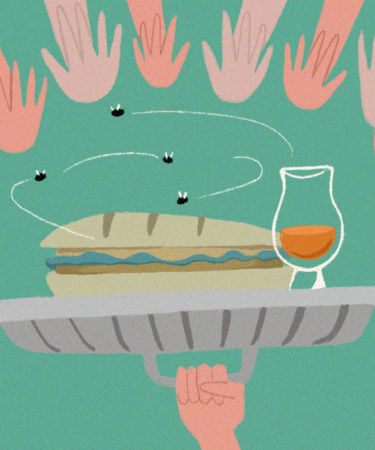In July 2020, the New York State Liquor Authority (SLA) issued an ordinance requiring bars to sell food with all alcoholic beverages ordered by diners seated outdoors. Already reeling from the impact of the pandemic, operators without kitchen facilities found a quick workaround to the new mandate, introducing $1 menus with novelty food items such as “Cuomo Chips” and “Handful o’ Croutons.”
While his name adorned bar menus across the state, New York Gov. Andrew Cuomo was not impressed. The SLA soon updated the guidance, warning bar operators that food items had to be as substantial as a sandwich or bowl of soup, and that a bag of chips or handful of baked cubes of bread did not qualify. Cuomo Chips could live on, but only as a side dish.
At the risk of further wearing out a tired cliché, history sure has a strange way of repeating itself: Cuomo Chips are not the first example of New York bars serving novelty food items to circumvent newly introduced legislation, though modern-day diners can count themselves lucky that the 2020 workaround bore no resemblance to the previous incarnation — the infamous, and by all accounts inedible, “Raines Sandwich.”
In 1896, the State of New York introduced an alcohol excise law, which later came to be known as the “Raines Law” after its author, Sen. John W. Raines. The law restricted how and when alcohol could be sold in the state and aimed to crack down on public drunkenness, particularly in New York City.
The Raines Law took aim at the city’s thousands of seedy saloons by drastically increasing the annual cost of liquor licenses and raising the drinking age from 16 to 18, Darrell Hartman explains in Atlas Obscura. The law also prohibited the sale of alcoholic beverages on Sundays, except in hotels and lodging houses with at least 10 rooms, where drinks could be served with complimentary meals.
Savvy operators were quick to exploit this loophole and continued selling booze throughout the week.
Bar and saloon owners converted the extra space on their premises — from attics to basements — into the required number of lodgings. To meet the food requirement, they then devised the cheapest, nastiest solution imaginable.
When patrons entered one of the city’s new “Raines Hotels” and ordered a beer or shot of something stronger, a server would bring it to them along with a “Raines Sandwich.” No sooner had the plate been set down on the table, the sandwich would then be whisked back to the bar before accompanying another drinks order at a different table.
Drinkers would rarely complain. While satisfying the legal loophole, the sandwiches were never intended to be eaten, often containing rubber or even bricks wedged between two slices of bread. Even when ingredients like ham and cheese were used as the filling, the sandwich could remain in rotation at the bar for anywhere from an entire day to a couple of weeks.
Playwright Eugene O’Neill described the typical Raines Sandwich as “an old desiccated ruin of dust-laden bread and mummified ham or cheese.”
In “The Social History of Bourbon,” Gerald Carson writes, “Once in a while, some yokel picked up a Raines Law sandwich and tried to eat it, and everybody had a good laugh.” Carson also notes that there is at least one recorded incident of a man using a sandwich as a weapon during a barroom brawl, tragically ending his adversary’s life with one blow.
It soon became clear that the legislation had failed in spectacular fashion. Within one year of the law’s passing, New York City housed more than 1,500 Raines Hotels. All could now legally serve alcohol at any hour of the day and on any day of the week, and would ultimately continue doing so until the passing of Prohibition.
Rather than curb public drunkenness, the Raines Law fueled more disorder. When local authorities tried to push back, they were stunned to see the courts rule that a “sandwich” satisfied the requirements of being a sufficient “meal” — just as they would more than a century later.
